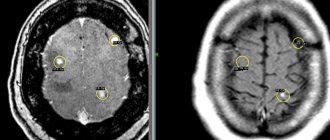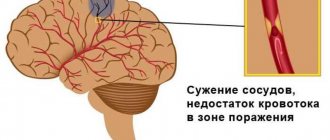Indications and contraindications
Since the tumor focus is most often benign, sometimes a specialist resorts to dynamic monitoring of its course - the patient comes for a follow-up examination, as well as conducting an MRI of the brain every six months. Surgical intervention for asymptomatic meningioma is usually not required.
The main indications for excision of such a neoplasm:
- rapid growth of the tumor defect;
- suspicion of malignancy of the process;
- the appearance of severe neurological symptoms - up to frequent convulsive attacks, paralysis of the limbs.
In addition to the indications, the neurosurgeon must consider possible limitations to the surgical elimination of the disease:
- severe somatic diseases - for example, decompensation of cardiovascular and respiratory activity;
- intolerance to drugs administered for anesthesia;
- infectious damage to the tissues of the skull;
- pronounced weakening of immune barriers;
- tendency to massive bleeding;
- deep location of meningioma;
- involvement of many neighboring brain structures in the process;
- advanced age of the patient.
The feasibility of an operation is a combination of many factors, including an assessment of the risk of complications. Only an experienced neurosurgeon is able to give a competent opinion.
What is a cyber knife?
This is a beautiful name for one of the methods of stereotactic radiosurgery. In preparation for the intervention, precise neuroimaging or final determination of all tumor parameters is performed. The technology itself includes radiation surgery, computer navigation and robotics.
Cyber knife can hardly be called an operation in the usual sense of the word. There are no cuts, blood, stitches or painful dressings. The person simply lies on the treatment table. Above it is a robotic “arm” with a linear accelerator. The attached computer complex recognizes tissues altered by the tumor, and the doctor sees its three-dimensional model on the screen. The doctor and computer calculate the dose and location of radiation, and the robot carries it out. There is a function for adjusting to the patient’s movements. The accuracy of the irradiation is incredibly high - the robot can “miss” by a maximum of a millimeter. The robot irradiates the meningioma from several points until it is completely treated.
After this, the meningioma stops its growth or is destroyed. There are practically no negative consequences. There may be a short-lived headache, nausea and local swelling, which quickly disappear.
Rehabilitation after such exposure is practically not required. You can return to your normal life the next day. However, you should avoid overload and follow a daily routine.
Operation techniques
The rapid pace of development of neurosurgery in recent years has allowed doctors to develop several effective methods for radical surgery on meningioma. They make it possible to minimize possible negative consequences for healthy brain tissue, which has a positive effect on the further functioning of the organ.
Radical removal
After confirming the benignity of the meningioma, its size and location, the neurosurgeon selects the optimal method for removing the tumor for the patient. Classic surgical intervention allows you to completely prevent the growth of the lesion and minimize the risk of its possible relapse.
It is important to eliminate not only the meningioma itself, but also the fibers that extend from it to neighboring brain structures. The more thoroughly the defect is eliminated, the better the prognosis.
As a rule, the surgical method of removing brain meningioma involves craniotomy - opening its tissues to provide access to the pathological focus. Immediately before removing the tumor, the vessels that feed it are ligated to reduce the risk of bleeding.
Small defects are excised simultaneously - together with the capsule and even part of the meninges. A large tumor will be removed in parts, several times. The final stage of the operation is plastic surgery of the membranes, as well as bone marrow tissue.
The course of the postoperative period is usually favorable; complications are possible, but they are tried to prevent them. To do this, appropriate treatment is carried out - taking separate subgroups of drugs, for example, anti-inflammatory drugs, diuretics.
Stereotactic technique
If the classic option of eliminating meningioma seems difficult or impossible - there are contraindications to such treatment, experts consider the possibility of carrying out a modern method of stereotactic influence on the pathological focus in the brain.
Causes of the disease
There are no direct causes for the formation of such tumors. There are only risk factors through which meningoma can appear:
- Age over 40 years;
- Gender criterion. As practice shows, the risk of developing such tumors in women is three times greater than in men. This is due to the influence of hormones such as estrogen and progesterone, which provoke its growth. Men are less likely to develop meningomas, but they are more likely to have a malignant type of tumor. The most common form of this disease is convexital meningioma;
- Large ionizing radiation, which provokes the formation of various tumors in the cranial cavity. Today, this statement is controversial, since recent studies have shown that the occurrence of meningomas is associated precisely with a small amount of radiation;
- Genetic diseases. Most often, malignant meningomas are formed as a result of the presence of neurofibromatosis type 2.
Features of rehabilitation after surgery
A person who has undergone brain surgery may need from several months to several years to recover their health after removal of a meningioma. These terms will depend on the complexity of the intervention, the severity of the disease, and the patient’s initial state of health.
The main goal of rehabilitation measures is the return of a person to their previous everyday and professional activities or their maximum adaptation to the changes that have arisen in them due to the disease.
The following procedures come to the rescue:
- physiotherapy – myostimulation of paresis zones, magnetic therapy;
- massage - to improve blood supply to tissues, enhance lymph flow;
- Exercise therapy – to restore tone in the limbs, eliminate functional disorders;
- sessions with a psychologist - setting the right priorities and goals, overcoming psychological barriers to recovery.
Great importance is attached to support from relatives and friends: their participation in the rehabilitation of a person in the postoperative period is to set the patient up for a positive outcome of the disease, involve him in everyday activities, and help gradually restore work skills.
Symptoms
Very often, meningoma may not show any symptoms, so its presence may be discovered accidentally during magnetic resonance imaging, which was performed for other reasons. In most cases, the signs are initially very vague and develop gradually.
Symptoms are usually divided into general cerebral, which are caused by an increase in intracranial pressure, as well as an increase in the content of the cranial cavity, and local, which occur when meningoma puts pressure on anatomical structures.
General cerebral symptoms include the following:
- Headache that gradually increases, especially at night or even after lying down for a short time. Patients report an unbearable attack of pain, which can be compared to a migraine. This symptom is characteristic of many meningomas, but most often it is caused by a meningotheliomatous tumor;
- Violation of visual processes (loss of acuity, double vision, etc.). Restoration of vision is directly related to the effectiveness of treatment of the disease;
- Severe nausea and increased gag reflex during meals;
- Changes in the psyche and memory impairment. Very often, relatives of people who suffer from meninges note that patients suffer from retrograde amnesia, that is, events that happened a few minutes ago “fall out of memory.” As for changes in the psyche, this is provoked by an increase in anger and aggression. Often patients become depressed and close themselves off from others;
- Weakness in the limbs, which most often manifests itself on one side of the body. Patients lean to one side while walking and are unable to hold objects with their hands in the affected area. Falx meningioma also causes problems, in which patients may lose their legs;
- Epileptic seizures, which are initially accompanied by convulsions. Experts do not always give comforting results regarding the complete cure of this disease.
Possible consequences after removal of meningioma
Despite the achievement of high results in the field of neurosurgery, in some cases it is not possible to avoid the consequences of surgical intervention to remove meningioma. A certain category of people experienced malfunctions in the functioning of the following systems:
- visual – deterioration in the perception of images of surrounding objects, their blurriness, indistinctness;
- auditory – decreased hearing acuity;
- behavioral disorders - personality changes in some areas;
- imbalances, lack of coordination of movements;
- sensory disturbances in different areas of the body, weakness of the limbs;
- frequent headache attacks.
The most difficult complications to endure are infection of a wound in the skull area, as well as meningitis - if pathogenic microorganisms have entered the brain.
As a rule, death can be avoided with the help of powerful antibacterial agents, diuretics, and detoxification therapy.
However, the rehabilitation period will be extended, and restoration of certain functions will become impossible.
Another complication can be considered a recurrence of meningioma - the formation of a new focus in the same place of the brain or in another area. Neurosurgeons will use a different treatment regimen - a complex one, for example involving radiation exposure to the tumor focus.
Relapse
If the tumor was benign and its degree of malignancy is minimal, then after complete removal it will no longer recur. However, removing it completely is often very, very difficult due to its location, for example, at the base of the skull, or if several tumors are diagnosed at once.
If the formation was removed in the area of the cranial vault, then relapse can occur in only 3% of operated patients. For another localization, this figure is much higher, for example, when localized in the parasellar region, this figure will already be almost 19%, that is, it is in this number of people that the pathology will most likely develop again within 5 years.
For a neoplasm that appears in the area of the body of the main bone, this figure will already be 34%. But meningiomas that appeared in the cavernous sinus area almost always recur.
The histological type is also important. At the same time, benign forms recur very rarely - in only 3% of all cases, but malignant ones - in 78%.
Survival prognosis
It is quite acceptable to talk about the possibility of a complete recovery of a person with meningioma in the brain if the defect was identified at an early stage of its appearance, small in size and timely surgical removal. The benign course of the neoplasm, as a rule, does not cause complications. The prognosis for five-year survival is favorable.
Only a small number of patients – 1.5–3% – are at risk for the recurrence of pathology. For example, if you continue to work in hazardous work or have a negative hereditary predisposition - a tendency to multiple tumor defects of the brain.
The prognosis will be worse with an atypical course of meningioma. Such a neoplasm is more difficult to treat and is more often prone to metastasis and other complications. Only with timely removal of the primary tumor focus does the patient have a better chance of recovery. In the future, he must be observed by an oncologist and perform control examinations of the brain.
Nutrition
With meningioma, a healthy diet is necessary, which helps improve the quality of therapy and shorten the rehabilitation period. It is necessary to completely exclude smoked meats and fatty foods from the diet. You also need to give up tobacco products and alcoholic beverages.
Many doctors recommend the predominance of raw food in the diet, that is, eating foods that have been heat-treated as little as possible, this will significantly reduce the amount of carcinogens and toxins that enter the body with food.
However, it is not recommended to suddenly switch to such a diet; this should be done gradually, and first it is better to consult a nutritionist.
Reviews from doctors about meningioma removal
Many years of experience in performing brain surgery allows me to say with confidence: the achievements of modern neurosurgery are incredible. If earlier the removal of meningioma seemed to be a difficult task with an almost unpredictable outcome, now it is a completely ordinary operation. Several excellent techniques for tumor excision have been developed and tested without damaging healthy tissue. The patient quickly restores his functions - the rehabilitation period is relatively short, and its course is favorable.
Mikhail Vladimirovich, 47 years old, neurosurgeon
The human brain is the most mysterious organ. Many diseases in it have not yet been fully studied, as well as ways to combat them. So, meningioma is a seemingly benign neoplasm. But it is better to remove it in time to avoid complications. For example, degeneration into cancer. Many of my patients who have undergone such surgery leave positive feedback about the art of neurosurgeons. Recurrence of meningioma occurs extremely rarely in this case.
Maria Karlovna, 51 years old, oncologist
Treatment with folk remedies
Treatment of meningioma necessarily includes conservative methods, but modern medicine allows them to be combined with the use of folk remedies. There are several recommendations for those patients who have been diagnosed with benign brain tumors:
- It is recommended to completely abandon table salt, as well as increase the intake of vitamins D and A. It is necessary to completely abandon bad habits and increase the amount of fermented milk products in the diet;
- Take decoctions of calendula flowers. You can buy them directly at the pharmacy. They are sold both in the form of dry herbs and in special filter bags that can be immediately brewed into tea. You need to take such decoctions three times a day;
- An excellent remedy is a decoction of viburnum fruits. To do this, you need to mash the fruits, pour boiling water over everything and let it brew for 30 minutes. Take one glass of decoction three times a day;
- To eliminate or reduce fluid accumulation, it is recommended to use compresses and lotions based on medicinal clay. It is applied in a thick layer to the area of the head where the tumor is located. A teaspoon of vinegar must be added to the clay, and the compress itself must be kept on the head area for two hours;
- Decoctions of mint and rosehip help well. The herbs are brewed like tea and infused for 15 minutes. Such decoctions will help overcome weakness, body aches and relieve headaches.
Treatment of meningoma with folk remedies includes the use of a large number of different methods, but before using them, you must always consult with your doctor.
Prevention
No special preventive measures have been developed to prevent the development of the disease. However, experts recommend adhering to general rules. First of all, you need to lead an active lifestyle - spend more time outdoors, walk, play sports.
It is equally important to ensure proper balanced nutrition. Smoked meats, rich broths, fast food, fatty meats and fish should be removed from the diet.
It is imperative to stop smoking and drinking alcohol.









